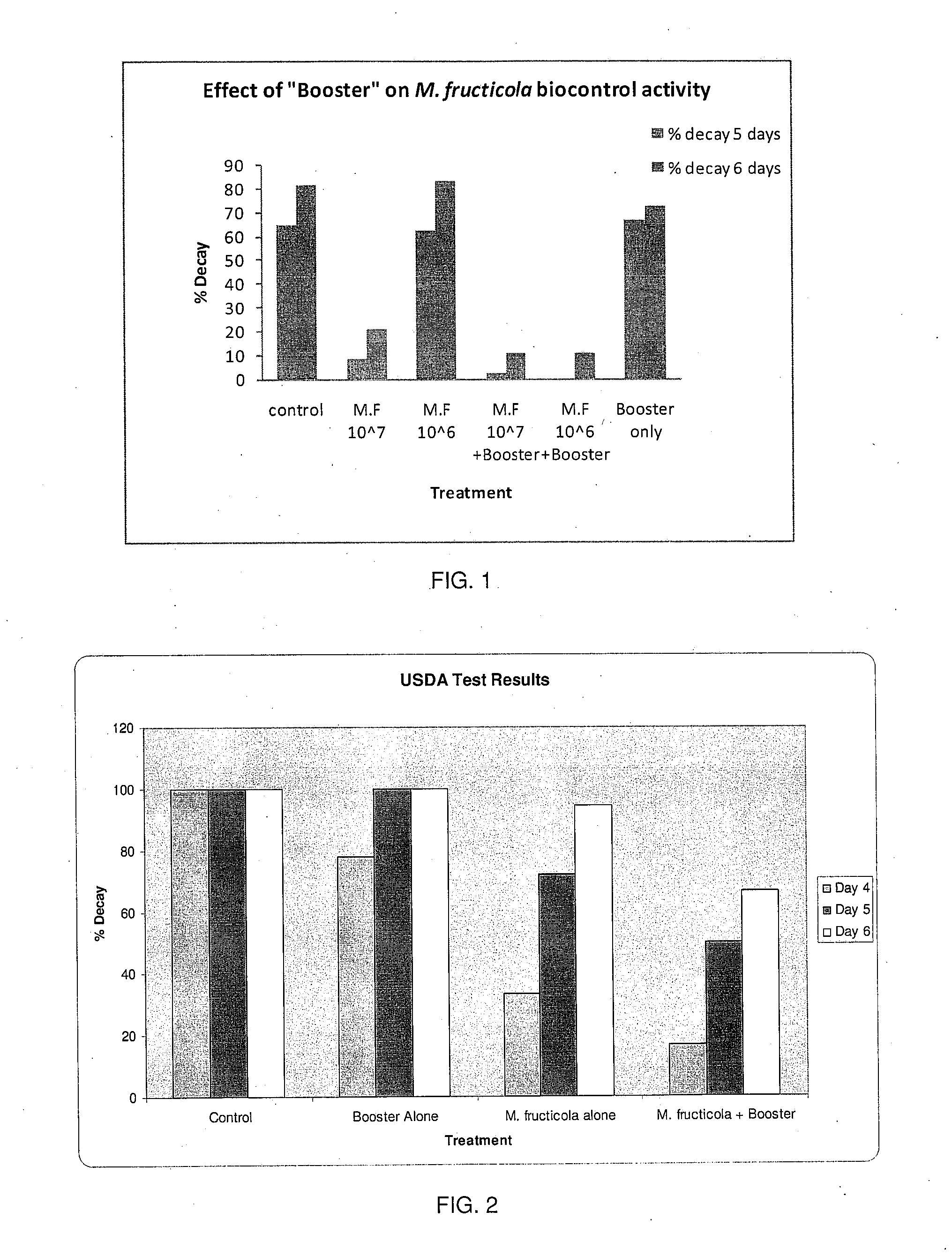Formulation and method for treating plants to control or suppress a plant pathogen
a technology for plant pathogens and forms, applied in the field of forms and methods for controlling and suppressing plant pathogens, can solve the problems of wasting a lot of time and expense, and achieve the effect of enhancing the activity of antagonism microorganisms
- Summary
- Abstract
- Description
- Claims
- Application Information
AI Technical Summary
Benefits of technology
Problems solved by technology
Method used
Image
Examples
examples 1-7
[0086]Multiple field trials were performed to test the efficacy of different formulations of the inventive compositions for plant disease control. Trials were conducted and disease reductions were noted in grape and turf, and yield enhancements were seen in tomato and strawberry, compared to the negative controls. Further trials were conducted and disease reductions were noted in apple, tomato, crabapple, grape, and turf. In total, 10 trials were conducted, and disease reductions relative to the negative controls were noted in 7 trials. Overall, plant disease suppression is generally indicated by the data.
[0087]Formulation Descriptions:
[0088]All formulations were prepared from Kaolin clay, yeast extract, a calcium source material, Yucca extract, and a microbe mix. The microbe mix contained: Baccillus licheniformis, Bacillus azotofomrans, Bacillus megaterium, Bacillus coagulans, Bacillus pumulis, Bacillus thurengiensis, Bacillus stearothermophilis, Bacillus subtilus, Bacillus amyloli...
example 8
[0094]The ability of the inventive booster formulation to improve the performance of an antagonistic microorganism was tested using the antagonistic microorganism Monilinia fructicola. The test was to see if the inventive booster formulation improves the ability of M. fructicola to inhibit post-harvest rotting of citrus.
[0095]A booster formulation was prepared according to the following formula (per 500 ml of booster formulation):
[0096]1.18 g Kaolin
[0097]0.39 g CaCO3
[0098]0.39 g Yeast extract
[0099]0.39 g Yucca
[0100]The booster formulation was applied in 10 μl treatments. After 2 hours, the plants were inoculated with P. digitatum. Disease incidence was investigated from 4 days to 6 days. The incidence represented the percentage of fruit displaying rot
[0101]FIG. 1 shows that the inventive booster formulation improves the ability of M. fructicola to inhibit post-harvest rotting of citrus.
[0102]It can be seen from FIG. 1 that the inventive booster formulation improves the ability of t...
example 9
[0103]The ability of the inventive booster formulation to improve the performance of an antagonistic microorganism was tested using the antagonistic microorganism Monilinia fructicola. The test was to see if the inventive booster formulation improves the ability of M. fructicola to inhibit post-harvest rotting of apples.
[0104]A booster formulation was prepared according to the following formula (per 500 ml of booster formulation):
[0105]1.18 g Kaolin
[0106]0.39 g CaCO3
[0107]0.39 g Yeast extract
[0108]0.39 g Yucca
[0109]The booster formulation was applied in 10 μl treatments. After 2 hours, the plants were inoculated with P. expansum (10 μl, 1×105 spores / ml). Disease incidence was investigated from 4 days to 6 days. The incidence represented the percentage of fruit displaying rot.
[0110]FIG. 2 shows that the inventive booster formulation improves the ability of M. fructicola to inhibit post-harvest rotting of apples.
[0111]It can be seen from FIG. 2 that the inventive booster formulation ...
PUM
 Login to View More
Login to View More Abstract
Description
Claims
Application Information
 Login to View More
Login to View More - R&D
- Intellectual Property
- Life Sciences
- Materials
- Tech Scout
- Unparalleled Data Quality
- Higher Quality Content
- 60% Fewer Hallucinations
Browse by: Latest US Patents, China's latest patents, Technical Efficacy Thesaurus, Application Domain, Technology Topic, Popular Technical Reports.
© 2025 PatSnap. All rights reserved.Legal|Privacy policy|Modern Slavery Act Transparency Statement|Sitemap|About US| Contact US: help@patsnap.com

